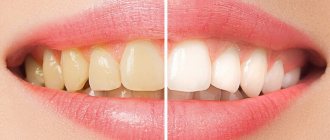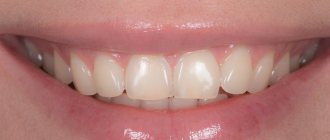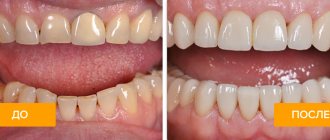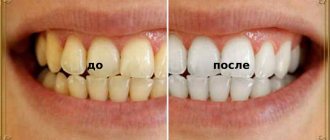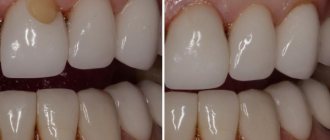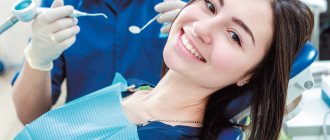Now many people are thinking about teeth whitening, and they can be perfectly understood: a beautiful smile will highlight any image and make a person more presentable. But it happens that a person has several artificial crowns and thinks about whitening tooth enamel. Then the dentist is asked the question: “Is it possible to whiten metal-ceramic crowns?” The only possible answer is: no! This is due to the fact that bleaching agents only affect natural enamel. Such products cannot lighten orthopedic structures.
If you plan to install crowns, then whitening should be done before prosthetics. When the enamel becomes lighter, you can begin installing orthopedic structures. Then the smile will be evenly snow-white, since the orthopedist will select the color of the ceramic coating to match his own enamel. Is it possible to whiten metal-ceramic crowns after they are installed? Answer: no! Here you can either accept it or completely change the design, which will require large financial investments.
Metal-ceramic crown
Modern materials used to make crowns are extremely durable and resistant to dyes. They are quite smooth and non-porous, so pigments cannot penetrate their structure. This is what allows you to limit yourself to daily oral hygiene using a toothbrush and regular paste.
If the material does darken, it is unlikely to be bleached. Metal-ceramics is a very hard and dense material in its structure; none of the modern brightening agents is able to penetrate inside it. In this case, it is possible to talk only about slight lightening, but not about whitening by several tones.
If the crowns are located on the side of the chewing teeth, then nothing will hinder the whitening of the smile area. Moreover, even a strong difference in shades will not affect the patient’s appearance in any way, because others simply will not notice it.
Is it possible to whiten teeth at home?
To maintain the natural whiteness of your teeth, it is important to brush them twice a day with a properly selected brush and toothpaste, rinse your mouth after every meal, use floss and antibacterial rinses, give up cigarettes and coffee, and undergo a professional procedure. hygiene every six months.
But if you naturally have a slightly yellowish or grayish tint to your enamel, even following all of the above measures will not be able to ensure an impeccably white smile. To do this you will have to resort to bleaching. This can be done at home in several ways:
- pencil - brightening gel is produced in a special tube, at the end of which there is usually a soft brush, brush or sponge for convenient application of the composition to the enamel surface. You must use the whitening pencil strictly according to the instructions. Typically, the gel is applied twice in the morning and evening for 2 weeks.
- strips and aligners - the gel can be immediately applied to the strips, which should be glued to the outside of the teeth for a certain time. Other systems include special mouth guards. Their inner surface must be independently coated with a lightening composition and then put on the dentition,
- abrasive pastes - they usually contain coarse abrasive particles, due to which the whitening effect is achieved. However, you cannot use them on an ongoing basis, otherwise you can damage the enamel, which will lead to its weakening and increased sensitivity - the development of hyperesthesia.
When whitening at home, a tray with a special gel is often used.
Before trying any of the methods described above, you should definitely consult a doctor.
The specialist will conduct a visual inspection and determine the current condition of the enamel, and give his recommendations on choosing the appropriate system. If the enamel is weakened, thinned or too sensitive, the use of whitening strips and abrasive pastes is strictly contraindicated.
Ultrasonic cleaning of the oral cavity and results
You can lighten artificial dentures a little and restore the attractiveness of your smile with the help of professional cleaning. The whole point of this method is to eliminate plaque, tartar, food particles and deposits that have accumulated on the surface. Currently, specialists use a variety of methods for processing enamel; ultrasonic scalers are in great demand.
This method involves the use of a special device through the tip of which ultrasound and microvibrations are applied. They are capable of destroying even the hardest plaque in just a few seconds without much effort. Simultaneously with ultrasound, the device delivers a stream of water, due to which the enamel is protected from overheating, and crushed particles of contaminants are washed out from its surface.
Dental clinic specialists strongly recommend cleaning your mouth at least once every six months; this will protect the enamel from the accumulation of hard stone and preserve the health of your teeth for a long time. However, this procedure is also ineffective in whitening fillings and crowns.
How to protect yourself from problems with dentures
In order for new teeth to maintain an attractive appearance for a long time and not cause other problems, you must initially carefully approach the choice of a clinic and an orthopedic dentist. It is advisable if dentistry has its own dental laboratory, where modern and high-quality ceramic materials are used. For example, ceramics, glass ceramics, fluorapatite, zirconium dioxide from Ivoclar Vivadent (IPS E.Max), Prettau, Kuraray Noritake, VITA Zahnfabrik. And the specialists were trained by material manufacturers, i.e. know how to handle them correctly.
Another important step is that before prosthetics, professional cleaning with ultrasound and Air-Flo is required, and sometimes professional whitening. After all, if your enamel is covered with plaque, then it looks darker than its natural shade - that is, the prosthesis will be made the same color. And then the patient wants to whiten his teeth or even just have his teeth professionally cleaned - as a result, the crown or veneer will turn out to be darker than the rest of the row. Therefore, do not neglect professional cleaning BEFORE prosthetics - a good dentist himself will offer to undergo it, because... understands all the risks.
Installation of veneers and lumineers
As mentioned earlier, ceramic and plastic crowns are practically not amenable to any of the modern methods of whitening; they can only be cleaned of dirt accumulated on the surface. That is why many patients prefer using more advanced methods of dental restoration, for example, installing veneers.
Veneers are invisible overlays on the frontal area of the teeth, which are fixed using a special dental glue. With their help, you can easily disguise small chips, cracks, darkening of the enamel, as well as slight curvature and even gaps between teeth. These linings are made from very durable and resistant to external influences materials.
An even more reliable and aesthetically attractive option is lumineers. These are exactly the same pads, but thinner. Thanks to this, pre-grinding of the units is not required. Each of these prosthetic options involves taking impressions of the jaw, on the basis of which the onlays themselves are subsequently made. Quite often, doctors prefer to install veneers directly, that is, using a composite material and directly in the patient’s mouth.
Is it possible to lighten an artificial tooth that has been made too dark?
No, you won't be able to do this. After all, the shade of the ceramic is selected at the stage of making the prosthesis - then the product is baked in an oven, and the color is fixed forever. If the dentist made a mistake with the shade, then he will either have to redo the prosthesis (change the ceramic lining on a metal-ceramic crown, for example), or even make a new orthopedic structure.
There is another option - to apply a special white varnish on top of the ceramic prosthesis (for example, Dental Paint). It will paint the crown or veneer only on top, and after several cleanings it will wash off. Therefore, such a solution to the problem cannot be called a high-quality solution.
Prevention
To ensure that fillings and crowns do not change their color or lose their attractiveness over time, it is very important to properly care for them. Care involves daily oral hygiene (morning, evening, and after each meal). It is also very important to remember to visit your dentist regularly for checkups.
In addition to the timely detection of enamel and gum diseases, the doctor can carry out preventive cleaning. If a patient has a bridge installed in their mouth, they should rinse the area between the crown and the gum tissue as often as possible. In this case, you can use a device such as an irrigator.
Other recommendations include abstaining from eating solid and coloring foods, strong coffee and black tea, red wine, quitting smoking and other bad habits. It is important to avoid strong temperature changes, as this can lead to loosening of the material and its darkening in the future.
previous post
Is it possible to treat teeth with stomatitis?
next entry
Is it possible to whiten ceramic crowns and veneers, and what whitening methods does dentistry offer?
Dentures made of ceramics or metal-ceramics do not always satisfy the patient with their quality, since the materials can darken over time and be stained by food, drinks, and tobacco smoke. Either the crown or veneer was initially made darker than desired. A logical question arises: is it possible to whiten ceramic teeth? The answer is not always clear, but there is always a solution to the problem. Read more about this in today's article.
Home teeth whitening system Dent 3D White
Dent 3D White teeth whitening technology is in many ways similar to popular home lamp whitening. In the same way, a special gel and a device that emits a light beam at a strictly defined wavelength are used to whiten teeth.
The active substance of the gel is carbamide peroxide, which releases atomic oxygen. This is the same whitening component that is used in professional whitening.
Under the influence of light, a gel with active oxygen penetrates deeply into tooth enamel, destroys pigments without changing the structure of hard tooth tissue.
The packaging design is reminiscent of the White light system, which suggests certain thoughts related to marketing.
Home teeth whitening using White Kiss trays
White Kiss whitening kit is another comprehensive system for home teeth whitening. The set includes 12 ml of whitening gel, toothpaste to maintain the whitening effect, and two thermoplastic trays.
The main active ingredient of the White Kiss whitening gel is carbamide peroxide 10%, a professional but safe product for teeth. To reduce the risk of developing enamel hypersensitivity after whitening procedures, the gel contains potassium fluoride and xylitol.
White Kiss toothpaste is designed to maintain the whitening effect of the gel. It is low-abrasive and contains sodium fluoride and xylitol, which effectively prevent caries. The paste also contains papain, which copes well with plaque, and pyrophosphates, which protect teeth from further plaque formation.
The set is designed for a one-week course - 7 procedures.
If we compare White Kiss with Global White, the manufacturer of White Kiss speeds up the whitening process by increasing the concentration of the active substance, which means that for sensitive teeth it is preferable to use Global White.
Teeth whitening trays
Teeth whitening systems with a special tray can be purchased either in a store or from a dentist. It is a mouthguard shaped like a bite, with a whitening gel applied to it. The mouthguard is used for a specific period of time, usually from a few hours a day (for example, while sleeping) for four weeks or more (depending on the degree of enamel discoloration and the desired tone).
The whitening kit may include a gel activator lamp, the light of which, through a transparent tray, enhances the process of releasing oxygen from the gel.
Mouthguards can be universal, or they can be made in the clinic according to an individual impression.
Home whitening Zoom Day White and Night White
Day White ACP is a daytime whitening system that contains an active gel based on 7.5% or 9.5% hydrogen peroxide. The composition of the Day White ACP gel also includes: amorphous calcium phosphate (ACP) - adds shine to the enamel, reduces its permeability, and potassium nitrate - to reduce the sensitivity of the enamel. The recommended course of whitening is up to 2 weeks, 2 times a day for 30 minutes.
Night White is a night whitening system that contains an active gel based on 16% carbamide peroxide. The gel also includes amorphous calcium phosphate (ACP) to restore damaged enamel. For effectiveness, the Night White system uses custom trays made using a vacuum former. The recommended course of use of Night White is from 9 to 27 days for 5-7 hours.
White smile home whitening system
Teeth whitening system White Smile photo-whitening technology. The difference between the method is that active oxygen passes to the dentin of the tooth through the enamel matrix, where it cleans it of dark particles on which the color of the tooth depends. It is considered highly effective and completely safe even for problem teeth.
The teeth whitening process in this system is quite simple. It is necessary to apply the gel to the teeth, turn on the device emitting LED light, and point it at the teeth whitening area.
The White Smile system kit includes an LED light device, gel A, dental tray, gel B, instructions, 2 batteries.
The patented formula of White&Smile products was developed in France, production is carried out in Italy, and the products meet the safety requirements of the European Union.
Home whitening Beyond
Beyond Home Edition home whitening system is based on the Beyond Power Whitening Accelerator professional whitening system. The technology involves the use of cold light with a wavelength of 480 nanometers, which is comfortable for the patient. Using 18 high intensity light emitting diodes, this light triggers a special film and a specially formulated whitening gel. The system replicates the accelerated whitening used in the Beyond Power Whitening Accelerator system in dental offices.

